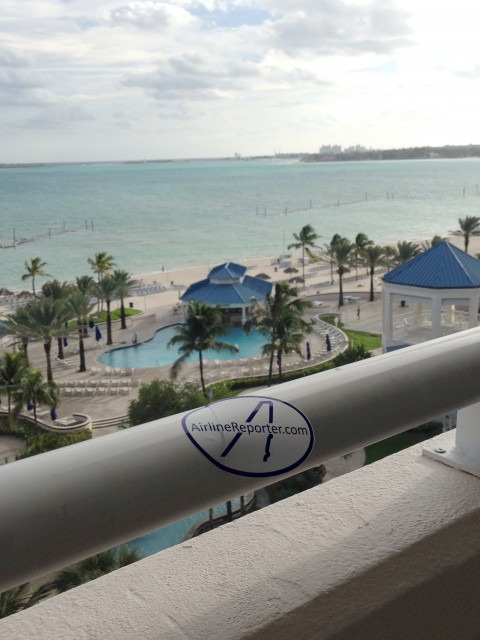
Even in The Bahamas, the view is always better with AirlineReporter! And no, I did not end up vandalizing the hotel – Photo: Blaine Nickeson | AirlineReporter.com
Recently, the Nassau Airport Development authority in The Bahamas opened a new $83.5 million terminal to serve all non-US international destinations, as well as ’œFamily Island’ domestic travel (a new US-preclearance terminal opened a few years ago). AirlineReporter.com was invited by the Bahamian Ministry of Tourism to come tour the new airport and view the sites and some new developments in Nassau (including the $3.5 billion ’“ with a ’œB’ ’“ Baha Mar development project). Note: While I was a guest of the Ministry of Tourism on this trip, all opinions are my own.
In this part, I will cover the “experience” of getting to Nassau, as well as the amazing cultural exchange opportunity I was afforded on the night of my arrival.
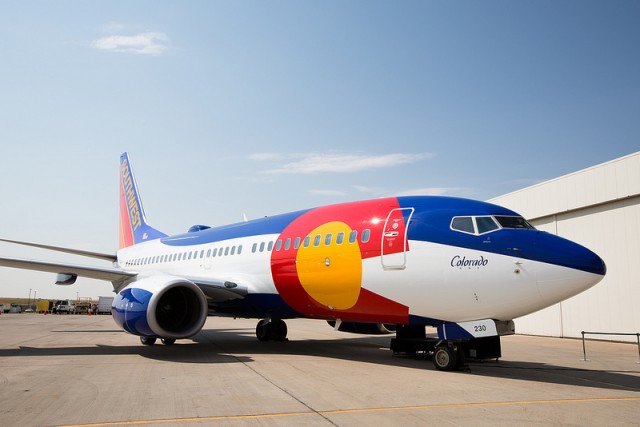
It was dark out and I was rushing to get to my Southwest flight, so I wasn’t able to take a photo. Image: Stephen M. Keller / Southwest Airlines
TRAVELING TO NASSAU (NAS)
My day began very early in my hometown of Denver. I arrived at Denver International Airport (DIA) at about 4:15 am for my 6:15 flight. This would be my first trip ever on Southwest Airlines, as a code-share flight through subsidiary AirTran. The problems began 24 hours before my flight.
For any other flight I take, I’m diligent about making certain I check-in online at T-24 hours. While I hadn’t flown Southwest before, I knew a prompt check-in was even more important, given their free-flow boarding. When the time came, I tried to check-in with both the AirTran and Southwest websites, only to be thwarted by each of them. Southwest wouldn’t let me check-in because I was booked through AirTran, and AirTran wouldn’t let me check-in because I was connecting on to an international flight (and thus needed my passport checked).
Knowing this, I arrived two hours early at DIA, only to find a massive Southwest Airlines line — sigh. I joined the queue and waited over 30 minutes before making it to a kiosk. The machine then rejected my passport, and I had to wait to be helped by a human. I was issued a boarding pass with a depressing boarding number: C8 (check out this story for those of you that aren’t familiar with the WN boarding process).
’œC8’ meant, worst-case scenario, that I would be boarding #128 on my 143-seat Boeing 737-700. While I could have lived with a back-of-the-bus middle seat, I was worried about my bag. Given that I only had a one-hour layover in Baltimore (BWI), I knew I couldn’t afford to gate-check my carry-on if the overhead bin space was full.
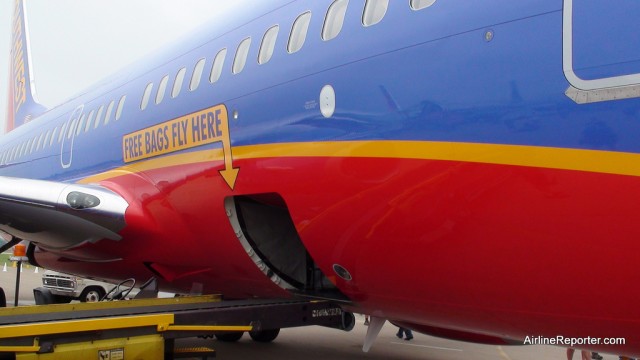
Bags might fly free down below (at least for now) but with a tight layover, I didn’t want to change checking my bag.
After leaving the ticket counter, I approached a security line that looked like The Beatles were all alive again and selling tickets. Given that it was barely 5:00 am, there was only one line open for hundreds of passengers. If I were flying United, like usual, this wouldn’t have been a huge deal; I have elite status with UA and could have jumped to the front. Today, I joined the back of the snaking line and started to panic. I knew I’d have to clear security and then ride the train to the C Concourse.
I waited in security for over 45 minutes, at which point I ran for the train my gate. Once I arrived, I was pleased to see they hadn’t started boarding yet. Still saddled with a ’œC8’ boarding number, I noticed a sign at the podium that said ’œBoarding Position Upgrades Available.’ I approached the gate agent, gladly handed over $40, and was rewarded with an ’œA8’ boarding number. I landed in an aisle seat in row 1, with plenty of overhead storage for my carry-on — best money I’ve ever spent.
I had a pleasant flight on Southwest; I can see why people like them. The flight attendants were friendly, goofy, and handed out free mini-shortbread cookies. The in-flight wi-fi (and free TV, courtesy of Dish Network) worked flawlessly. My biggest complaint was that the bulkhead row had no tray tables. Not even in the armrest. Perhaps it is a weight-saving feature of the new evolve interior, but it was very challenging to work on my laptop for a three-hour flight.
We arrived at BWI a few minutes early and while waiting, I grabbed a beer and one of the worst crab cakes I’ve ever had in my life (only $20!) and then headed to board my AirTran flight to NAS. For what it’s worth, I hadn’t been in the new BWI A-concourse yet, and found it light, airy, and comfortable.
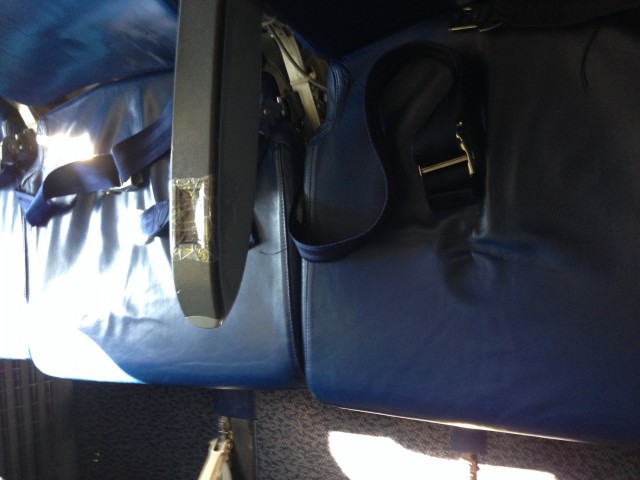
Awesome in-flight entertainment on my AirTran Boeing 737-700 – Photo: Blaine Nickeson | AirlineReporter.com
The AirTran Boeing 737-700 I boarded (N168AT) had lived a hard life. While waiting to enter the plane from the jet bridge, the guy in front of me occupied himself by scraping the peeling paint with his fingernail.
There was some excellent IFE on the flight (a missing panel in the armrest, covered over with packing tape). My seat didn’t have the ability to stay in the ’œupright and locked’ position any longer. It was extremely obvious that Southwest/AirTran is just planning to run these AirTran interiors in to the ground until the plane gets painted purple and sees an interior refit. It makes business sense, but for the short-term, it doesn’t make the flights too comfortable.
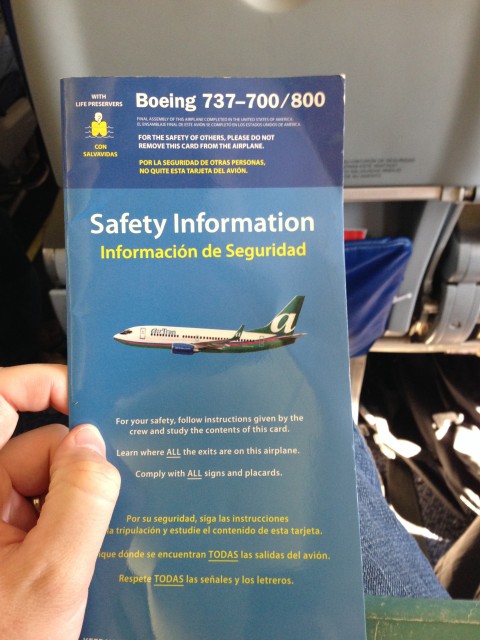
AirTran Boeing 737 safety card – too bad they’ve never flown the -800! Photo: Blaine Nickeson | AirlineReporter.com
I was able to get some entertaining out of the safety card in the seat-back. It referenced the Boeing 737-800 (a type AirTran has never flown). Anyhow, the rest of the flight was pretty uneventful and I was excited to get to the Bahamas.
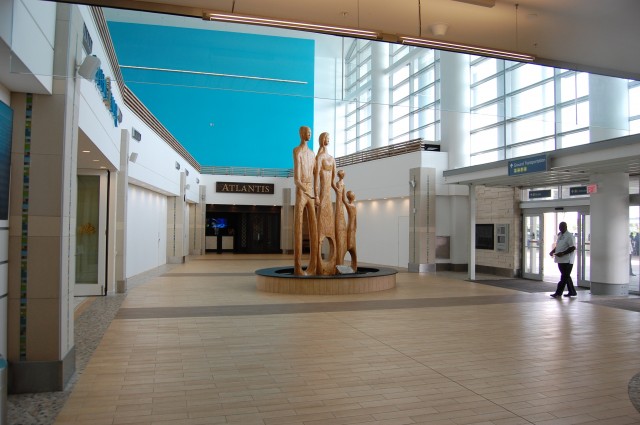
Arrivals area at NAS, with check-in lounges for the major resorts – Photo: Blaine Nickeson | AirlineReporter.com
Upon arrival at Nassau’s Lynden Pindling International Airport (LPIA), we approached a nearly-empty international arrivals concourse (literally, no other gate had a bird at it). It’s ’œlow season’ in The Bahamas right now, and it was a slow time of day, so I guess it was to be expected.
I was quickly off the plane, and there were no lines for immigration or customs. This portion of the airport was just completed about a year ago, and is beautiful; part two of this series will be feature the new LPIA.
A car was waiting for the brief 15-minute drive to the Sheraton Nassau Beach Resort, where I had a few hours to relax and explore before my evening event. Although the process of getting to the Bahamas was an ordeal, what I was about to experience made it totally worth it!
PEOPLE-TO-PEOPLE EXPERIENCE
At 6:00 pm, I met up with another travel journalist (Laura Motta from Sherman’s Travel) and we were picked for our dinner cultural exchange experience. The ’œPeople-to-People’ program is a signature offering of the Ministry of Tourism, pairing island visitors with an all-volunteer group of resident hosts. Visitors are paired with a host that has similar interests, professional experience, or family structure. In our case, our host Kwane Russell was an Air Traffic Controller at NAS, and a charter boat captain as well.
We travelled in towards the center of New Providence island (home to Nassau, and one of The Bahamas’ 660+ islands, of which only about 30 are inhabited) to a residential area before finding Kwane’s home. While both Laura and I were admittedly a little nervous about spending the evening at a stranger’s home, we couldn’t have been welcomed more warmly. We were given seats at a picnic table in the driveway, on what was a beautiful (albeit) windy evening. We were also offered a variety of local drinks (all of which I sampled).
As soon as we sat down, we were inundated with greetings from Kwane’s family and friends. His father, brother, nephew, and a variety of friends showered us with food, drink, and company. For drinks, I started with ’œSky Juice’ (which is fresh coconut water, coconut jelly/pulp, and gin). It was delicious and way too easy-drinking. At this point we were served a fresh conch salad. Conch is a large-shelled snail that is a staple of the Bahamian diet. To me, it tasted a lot like clam. The salad was prepared like a ceviche and was great.
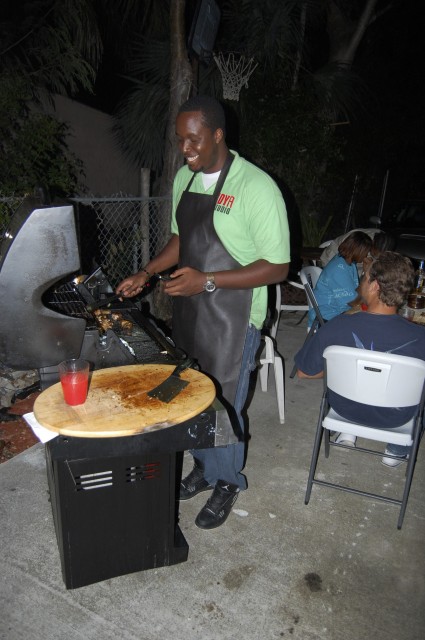
One of our amazing hosts for the People-to-People experience… I ate so much! Photo: Blaine Nickeson | AirlineReporter.com
We also drank Rum Punch and Kalik (’œThe Beer of the Bahamas’) and the food just kept coming. One of Kwame’s friends, a soft-spoken fella, was (to our benefit) also a professional caterer. He delighted us with pineapple bread, slow-grilled pork, grilled chicken legs and thighs, Bahamian mac and cheese (very unique), and – just when we thought we couldn’t eat any more ’“ an amazing fresh-caught grouper fish that was cooked in a lime and vegetable broth. The meal took two-and-a-half hours.
During the decadent meal, we heard about life in the Bahamas, local customs, and the stories behind everything we were eating and drinking. Everyone was incredibly friendly (before you say something, I honestly don’t believe most of them even knew we were journalists). Being an AvGeek, I made sure to pepper my Air Traffic Controller host with questions about NAS and its airlines.
The ’œPeople-to-People’ program is available to any tourist, free of charge. Running for a few years now, it hosts approximately 600 visitors per month and is made entirely of volunteer hosts. It’s not only available in Nassau, the capital, but also on the outer islands. The food and drinks we had were unbelievable, and ruined me for any further meals during my visit.
When it was time to go, our hosts gave us a warm send off. Kwane and his family said we would be ’œfriends for life’ to them and encouraged us to return to The Bahamans to be hosted by them again. They even offered to take us out the next night as well.
I can’t say enough about the ’œPeople-to-People’ program. As someone who can be shy, I was extremely uncomfortable heading in to a strange neighborhood to meet people I didn’t know. The program gave me a chance to experience Bahamian culture and hospitality in a way you just can’t pay for.
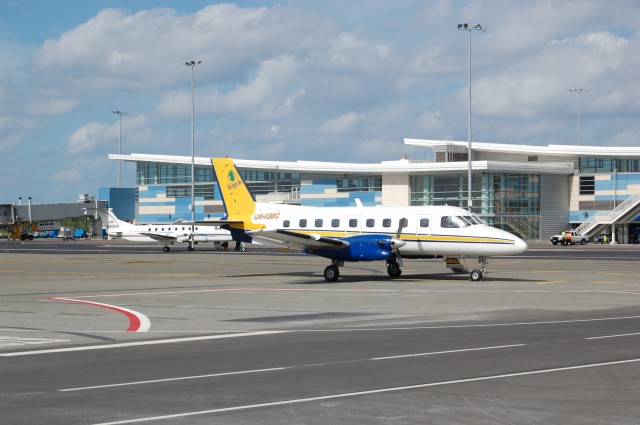
A preview of part 2, which includes a NAS tarmac tour. Check out that bird in the background – it was heading to Cuba! Photo: Blaine Nickeson | AirlineReporter.com
In part two, I’ll take you down on the tarmac at Nassau’s brand-new Lynden Pindling International Airport, we’ll explore the massive Baha Mar development project, and you’ll also see some of the famous sites of Nassau (including both a cigar and chocolate factory).
Continue reading with Part 2 of my Bahamas adventure…
Comments are closed here.
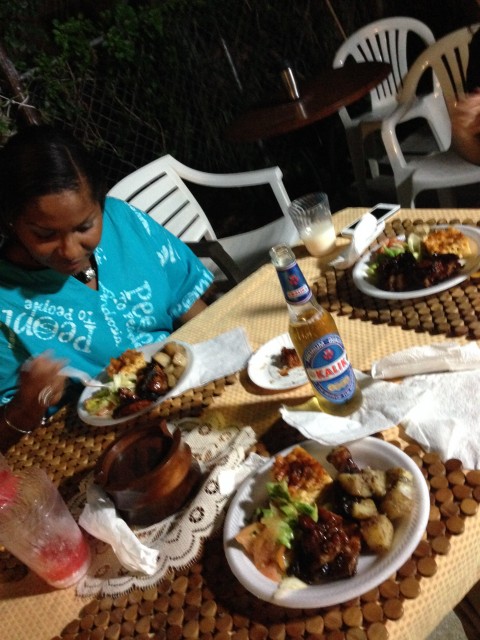
I enjoyed the enthusiasm and attention to detail of your report. So you were surprised by the re-heated, frozen $20 crab cake? I’m in shock to read it was not made fresh from locally sourced blue crabs and prepared by a Culinary Institute of America trained chef. Airline personnel tend to be a great source of what is good to eat at a particular airport.
I noticed you repeated having apprehension about meeting strangers. It defeats the purpose of travelling if getting to know the people from the destination is a source of anxiety. No professional can grow without taking the risk of engaging with people. My trip to Thailand was made memorable by a perfect stranger who took the time to show me the local hangouts.
Hi Jay – I wouldn’t have expected much, except I was in Baltimore, it was a famous crab restaurant, and claimed to be a “Top 10 Airport Restaurant” in the country. I’ve had great airport dining – i.e. Tortas Forntera at ORD and Elway’s at DEN. Just not in this case…
Great job Blaine. I found the article a year later. Thanks again!